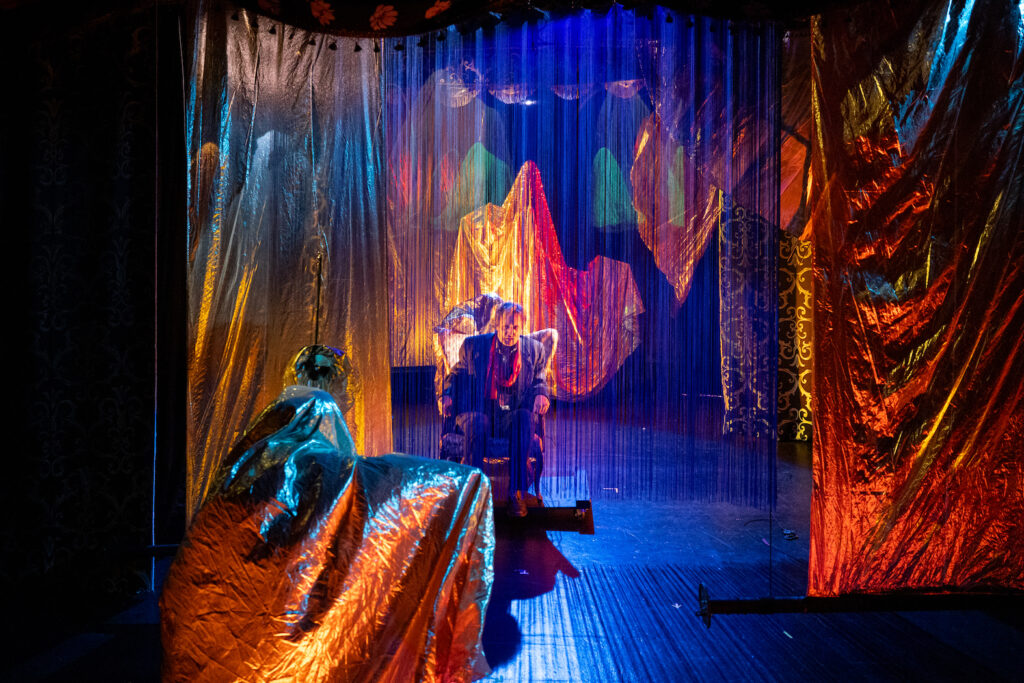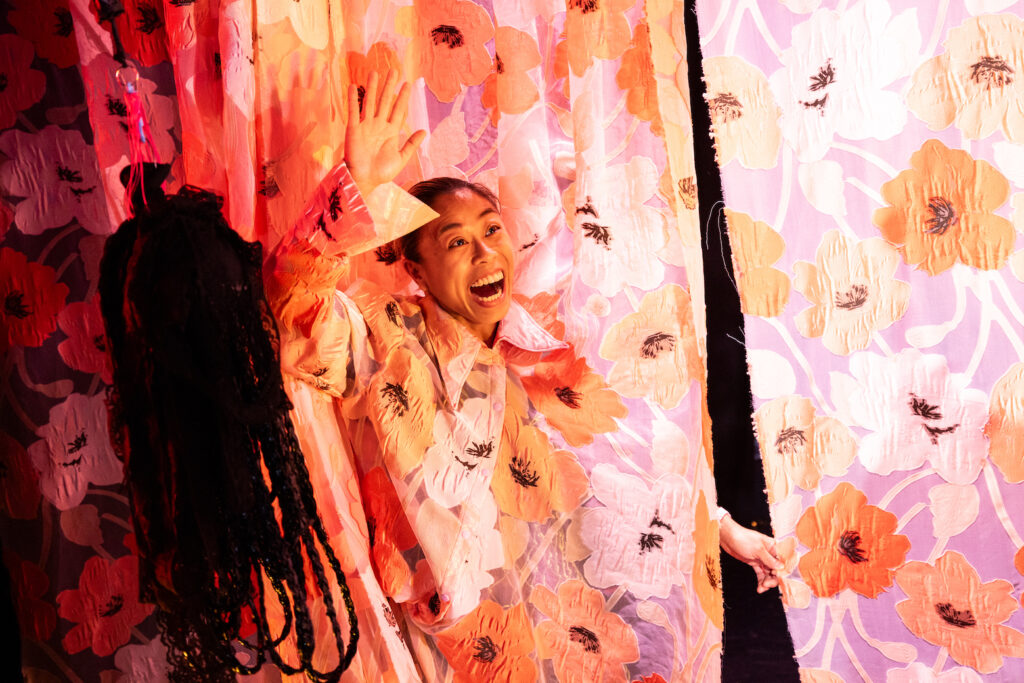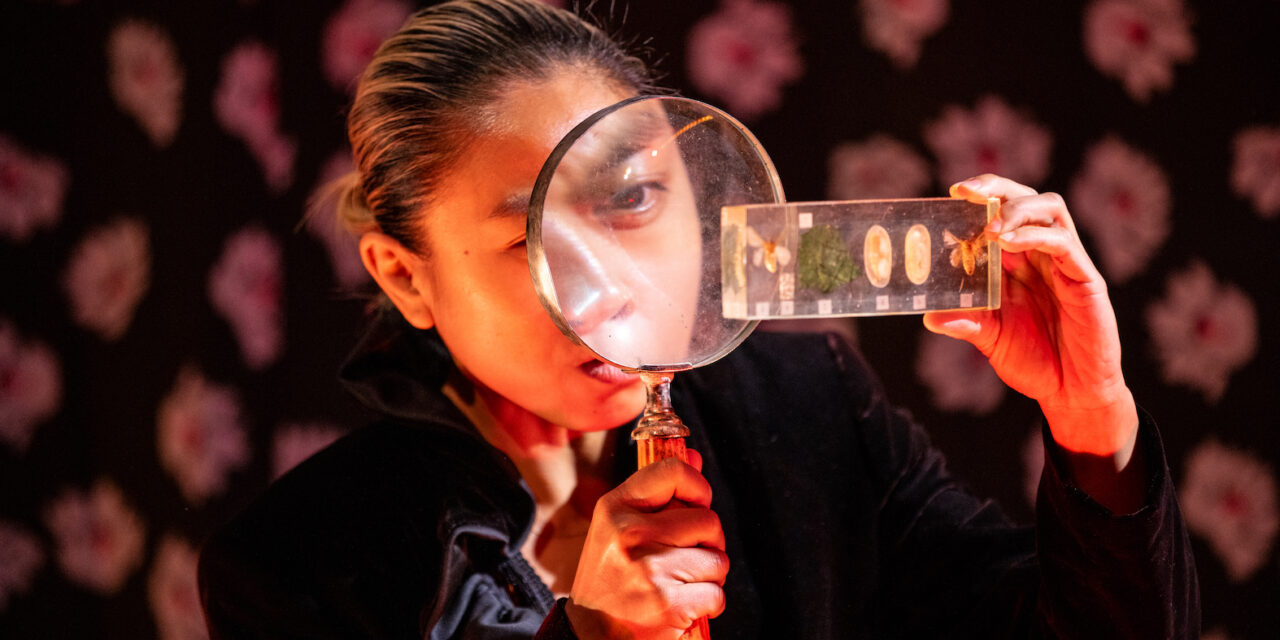By Samuel L. Leiter . . .
Psychic Self Defense—created, written, designed, and directed by Normandy Sherwood—is a throwback to the kind of cleverly cheesy experimental theater work of half a century ago; the kind of low-budget, make-of-it-what-you will, nonliteral, nonlinear, abstract, dreamlike avant-gardism described and theorized about in places like The Drama Review (TDR). More performance art than conventional theater, it’s congenially housed at HERE, long a downtown bastion of such hopefully envelope-pushing work. Once it begins, it lasts only about 50 minutes although audiences are told to expect 60.
At the appropriate time, the audience in the lobby is divided into groups of eight or so, each led, in turn, outside the venue before being let back in at another door that leads to a dimly lit backstage area divided by hanging draperies into a maze-like arrangement of multiple small spaces. The walls are adorned with colored light bulbs and various odd hangings such as you might expect to see in visiting a side-street palm or tarot reader’s den; the publicity release suggests a séance, but I didn’t get that vibe.

Stage assistants (who will be very active on stage) garbed in ghostly black with bizarre headdresses, guide you to the intimate space delineated by cloth hangings where bleachers with four rows hold about 40 closely packed seats facing a proscenium opening set behind a metal bar only inches from the front row. A shimmery gold curtain faces you as Craig Flanigan’s weird percussion music, sounding like bells and small gongs, among other sounds, establishes the atmosphere.
When the curtain finally opens the acting space reveals an actorish-looking, gray-haired, middle-aged man (Ean Sheehy) in a woolen sports jacket and slacks, an orange scarf about his neck. Seated in a club chair with a planter nearby, he rises and says something like, “I must practice the art of psychic self-defense,” makes a series of occult movements with his hands and arms, and, before long, like his scenic accoutrements, is swept away under the large, red-orange curtain that descends. We next meet a woman (Nikki Calonge) who, with a large magnifying glass, is inspecting some sort of miniaturized figures encased in Lucite; she says the same line about the need to practice psychic self-defense, makes similarly odd movements, and vanishes.
The line each speaks is the only dialogue in the event, which is essentially a fever dream dominated by a nonstop succession of visual effects employing what must be thousands of yards of fabric; bolts of material (from patterned cottons to tinselly strips) descend, billow, slide back and forth on multiple tracks, and create what we may call—to coin a phrase—textilian ballet. The work—which Sherwood considers “an homage to the physical space and objects of the theater”—revels in animating the inanimate, transforming the fabrics into sheet-like puppets engaged in a choreography of cloth. Christina Tang’s creative lighting and an abundance of offbeat projections (uncredited, although probably by Tang) add greatly to the overall effect.


Various kinds of curtains play important roles, some of them benignly beautiful, as when the folds in an upstage tab curtain produce a varicolored effect under Tang’s painterly lighting; others can be ferocious, like the one that consumes everything in its path. A highlight arrives when a small, self-enclosed proscenium stage, its cloth border adorned with baroque figures, moves into place, only to be rivaled by a similar stage, leading to the revelation of even smaller and smaller versions of such stages.
Another set piece involves two peculiar figures resembling God knows what—elongated wedding cakes?—the smaller one mostly blue, the larger mostly black, who swirl about the stage in what seems like a mating dance. Their smooth progress is apparently aided by rolling desk chairs whose casters can be just barely glimpsed beneath the towering structures. They’re joined by a more stationary golden figure I won’t try to describe—okay, it reminded me of a giant R2D2 droid—other than to mention that it seems to give birth to the child they’ve conceived. But what do I know?
One’s natural inclination is to try to extract meaning from such an expressionistic, hallucinogenic concoction. Is the piece intended to suggest the psychological turmoil experienced by the two otherwise unexplained people we meet at the beginning and at other times in the course of the action? Are those strange hand gestures an attempt to defend themselves from such turmoil? After a while, whatever concrete meaning you struggle to apply dissipates and you simply watch the artsy artfulness for its aesthetic or—on several occasions—humorous features.


There are actually a couple of books titled Psychic Self-Defense, although I have no idea what connection there is between them and Sherwood’s theater piece. Neither seems to be related, although the one with a subtitle about fending off paranormal attacks has vague potential. The other offers this blurb: “What is psychic protection and why do you need it? Maybe you find yourself having issues like insomnia, nightmares, poor sleep, or low energy levels. Does this occur around certain people and/or in certain places? Do you easily lose a lot of energy in these conditions? Are you regularly lacking in energy? Then you may need psychic self-defense to protect yourself against everything that is not serving you on your way to enlightenment.” Sherwood’s play, I’m afraid, doesn’t pretend to offer such protection.
Despite being immersed in its imagery, imagination, and otherworldly cacophony of bells, bongs, tinkling, whistles, static, and buzzing, I was not unhappy when the final curtain fell on Psychic Self Defense. It’s cleverly concocted, visually engaging, technically complex, and excellently executed; these positives, though, aren’t enough to overcome its excessive ambiguity, which weighs too heavily on its reception. I must report that the audience at the preview I attended clapped and clapped and clapped. I merely clapped.
Psychic Self Defense. Through September 30 at HERE Arts Center (145 Sixth Avenue at Dominick Street). www.here.org
Photos: Maria Baranova


















